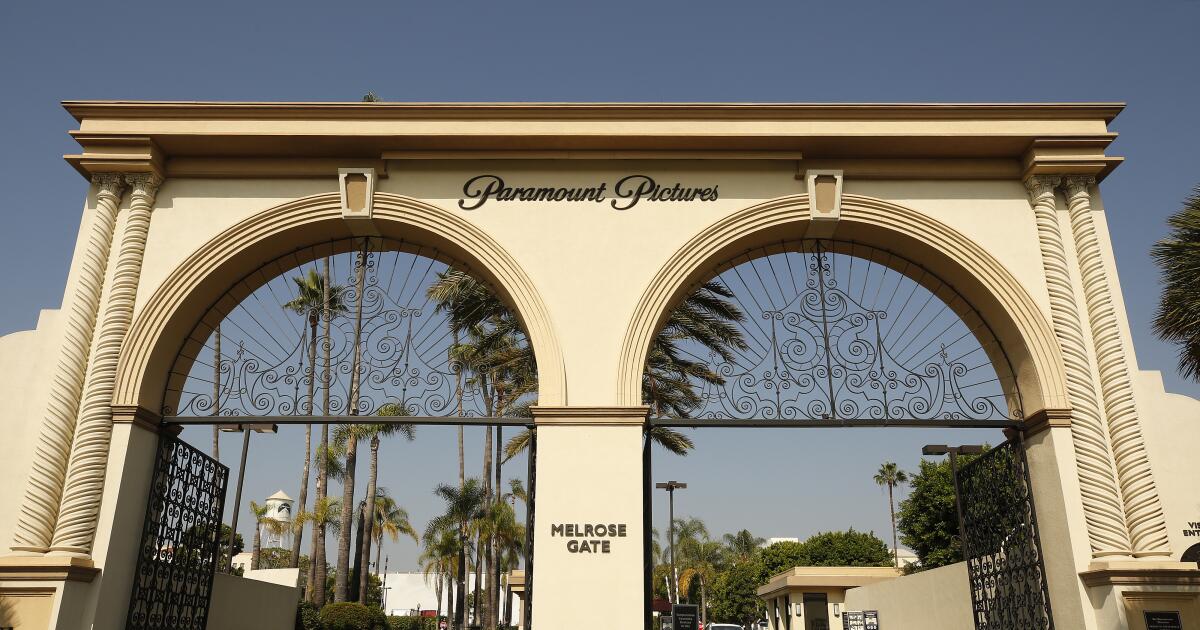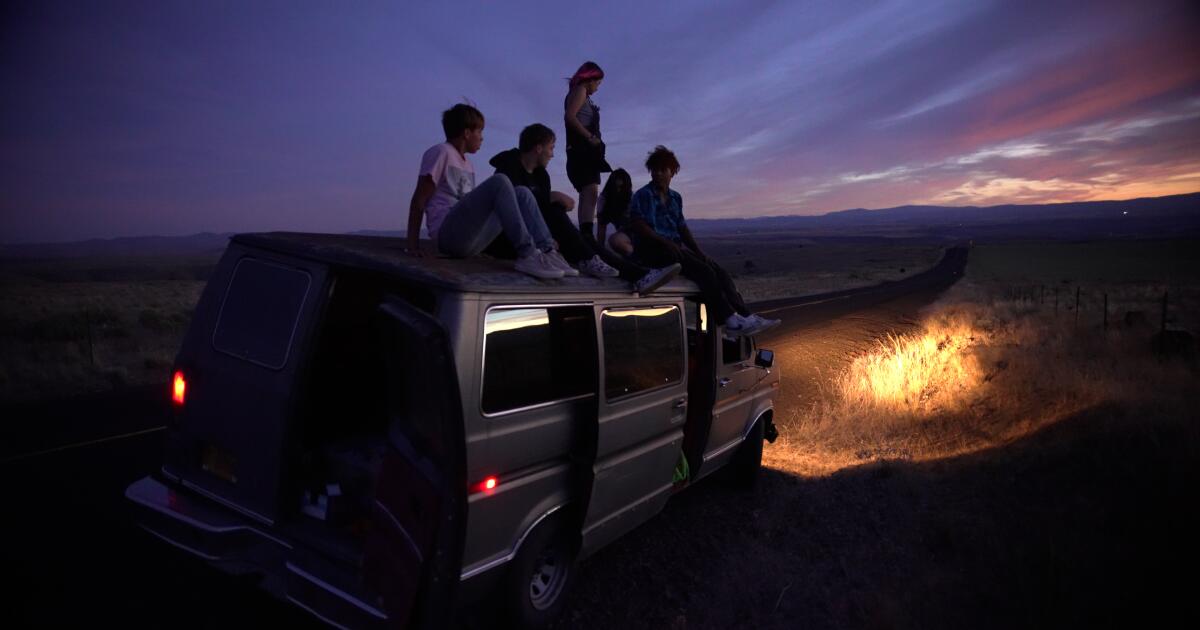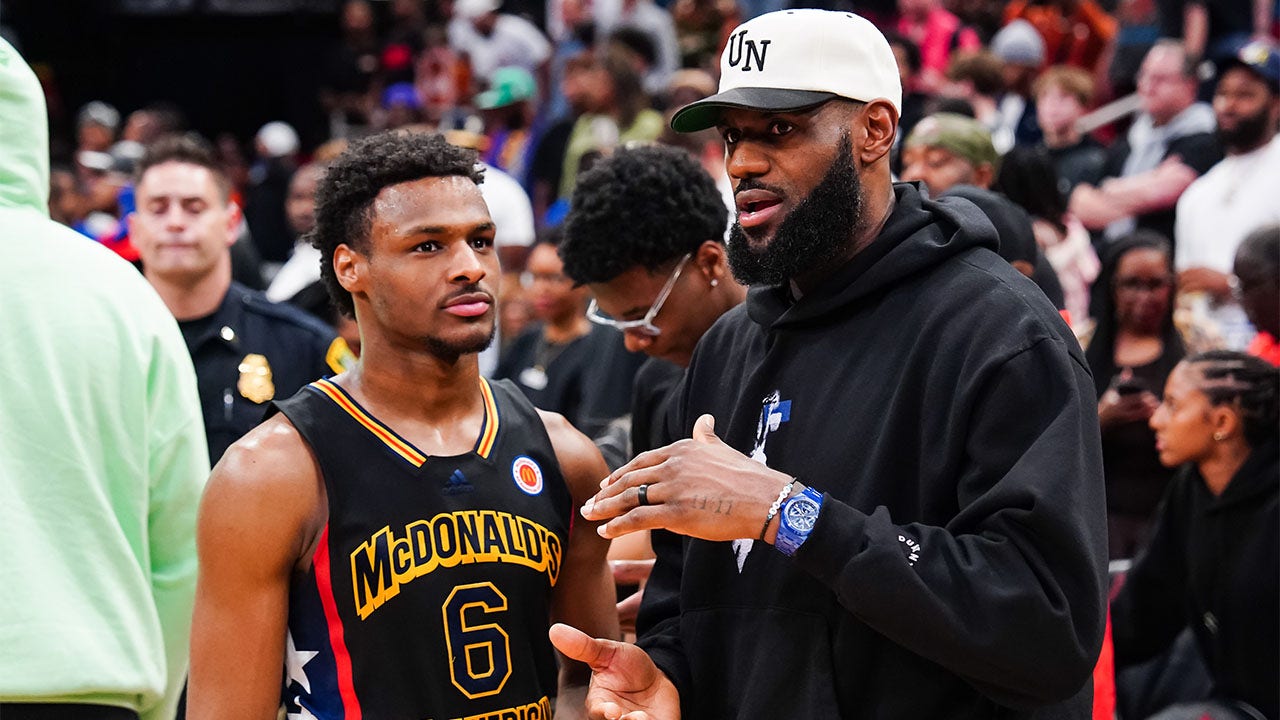Entertainment
Deal or no deal for Paramount? Here are the options on the table

Time is running out for Paramount Global and Skydance Media to reach a deal combining their entertainment empires within the 30-day exclusive negotiating window that closes Friday, and it appears likely that the week will pass without an agreement on a transaction.
Paramount, controlled by Shari Redstone , and Skydance, helmed by film producer David Ellison, have been trying to hammer out a complicated deal that would leave Ellison in control of the storied media giant. And so far, no agreement has been struck.
What has long looked like Paramount Global’s most viable buyout option has been the subject of weeks of palace intrigue, plagued by an investor rebellion and corporate shakeups. Paramount’s stock fell roughly 7% on Friday amid reports that the company was getting cold feet about Skydance’s offer.
New York-based research firm LightShed Partners said Friday that it expects the bargaining deadline to arrive sans agreement, with another bid from Sony Pictures Entertainment and Apollo Global Management on deck. The negotiation period is not likely to be extended, leaving the door open to other options.
The Times has contacted Paramount Global for comment. A spokesperson for Paramount’s mergers and acquisitions committee declined to comment.
The Skydance scenario
Since reports surfaced in January that Ellison’s Skydance was exploring an all-cash deal to acquire National Amusements Inc. — the company that holds 77% of Paramount Global’s voting stock — things have gotten messy.
Over the past month, Paramount has been negotiating with Skydance, which has linked up with investment firms RedBird Capital and KKR to take over National Amusements, which would give it control of Paramount, owner of the Paramount Pictures movie studio on Melrose Avenue, broadcast network CBS and cable channels MTV and Nickelodeon.
The talks spurred a revolt led by Paramount Global investors who expressed concerns that the deal on the table would largely benefit Paramount’s nonexecutive chairwoman, Redstone, at the expense of regular shareholders.
The investor uprising caused Paramount shares to plummet and prompted several of the company’s directors to step down. In an effort to quell the backlash, Skydance recently upped its offer with a cash infusion for Paramount and by setting aside funds specifically for Paramount’s nonvoting shareholders, which would probably reduce Redstone’s take.
All of this corporate turmoil culminated Monday in the termination of Paramount Global Chief Executive Bob Bakish, whose opposition to the Skydance deal did not sit well with Redstone.
Bakish preferred another Paramount Global suitor, private equity firm Apollo Global Management, which joined forces this week with Sony Pictures Entertainment to submit a $26-billion all-cash bid for the entertainment empire.
Sony-Apollo hover around the hoop
While this Paramount-Skydance saga has been unfolding, Apollo and Sony have officially entered the ring as a team.
Culver City-based Sony has offered to become a majority shareholder in the entertainment company, with Apollo as a minority owner.
Because Sony Corp. is based in Tokyo, Apollo would probably have to assume control of Paramount’s CBS network in order to abide by Federal Communications Commission rules that restrict foreign ownership of broadcast TV stations — a technicality that could make the offer less attractive to a company reluctant to divvy up its assets, according to analysts at LightShed.
Such a deal, while cleaner from a financial perspective, would cause upheaval in Hollywood. It would probably result in mass layoffs, reducing the number of major movie studios from five to four.
What if none of the above?
After Bakish was ousted, Paramount Global appointed three of its top entertainment executives — Paramount Pictures CEO Brian Robbins, CBS CEO George Cheeks and Showtime/MTV Entertainment Studios head Chris McCarthy — to lead the company in an “office of the CEO” capacity.
If a Paramount-Skydance merger fails to pass, analysts at LightShed Partners predict Paramount will move forward with its leadership trifecta, focus on restructuring its business and eventually revisit mergers and acquisitions discourse later this year or in 2025. The regulatory landscape is expected to become clearer after the 2024 presidential election.
The LightShed analysts said they doubt that Paramount will immediately pivot to a Sony-Apollo deal in the event that talks with Skydance fall apart.
“We’re only four days in so there’s not a lot I can say,” Cheeks wrote in a memo to Paramount Global staff. “But … Brian, Chris and I are in the process of finalizing our strategic plan that we’re going to roll out as soon as possible.”
Times staff writers Samantha Masunaga and Meg James contributed to this report.

Entertainment
Review: In 'Gasoline Rainbow,' carefree kids hit the road during a fleeting moment when they can

The New Orleans-based filmmaking brothers Bill and Turner Ross have made a name for themselves over the past 15 years with their lyrical, poetic documentaries. But with 2020’s “Bloody Nose, Empty Pockets,” they blurred the line between fiction and nonfiction, setting up an imaginary scenario in an actual dive bar on its last night of business, observing a curated group of regulars as they shut it down for good.
The new “Gasoline Rainbow” is their first official narrative feature, informed by their documentary roots and eye for capturing spontaneous beauty. During the Covid-19 quarantine of 2020, Bill and Turner Ross dreamed up a wild road film, which they loosely scripted and cast with five young first-time actors from Oregon. They play a group of friends from a small town called Wiley, who hit the road with the only things you need for an adventure: a dream, a posse, a van and the abiding belief that “anywhere’s better than here.”
The dream is to see the Oregon coast, 513 miles from their landlocked town. The posse is three boys — Makai Garza, Micah Bunch and Tony Aburto — and two girls, Nathaly Garcia and Nichole Dukes. The van gets them started on their adventure, but they soon learn that it’s not a necessary component. After spending the night partying in a cow field with a guy they meet on the side of the road, they return to find the van on blocks, vandalized, the tires stolen, and that’s when things really get interesting. They have to rely on each other and the kindness of strangers and community to make it all the way to the beach, to the Party at the End of the World, a mysterious event they hear about that becomes their ultimate destination.
Though the events on this journey are planned and produced by the filmmakers, the relationships are real, the interactions and conversations undeniably authentic. If pioneering English documentarian John Grierson’s definition of nonfiction filmmaking was the “creative treatment of actuality,” “Gasoline Rainbow” could ostensibly fit under that umbrella.
But this is not a documentary and it’s far more productive to consider the ways in which the Ross brothers have synthesized their influences and inspirations — such as “My Own Private Idaho,” “The Wizard of Oz,” “Easy Rider” and the 1984 documentary “Streetwise” — into their own unique form that exudes a singular kind of ragged, unpredictable vitality.
A scene from the movie “Gasoline Rainbow.”
(Department of Motion Pictures)
Each actor is a discovery with a special presence, but there is no one star or standout, which feels intentional. While “Gasoline Rainbow” is a heady slice of pure, uncut youthful energy, it is also a portrait of collectivism, caretaking and a celebration of mutual aid.
It’s apt that a film like this was born out of the isolation and confinement of 2020. There was a desire for freedom and movement, combined with the progressive value of taking care of each other that rose out of quarantine and the Black Lives Matter movement. In “Gasoline Rainbow,” the kids come by this sense of mutual protection naturally, but the value is reinforced along the way by the heavily-pierced punk hitchhikers who teach them how to hop a train to Portland in exchange for their leftover food, and the middle-aged rockers who provide a party, a couch to crash, breakfast and a boat ride. Micah’s cousin Noah underscores the importance, telling them, “I like the way you treat each other.”
These values of care and respect threaded throughout are why we never fear for their safety. They make decisions as a group, look out for each other and demonstrate their awareness by asking the strangers they meet, “Are you cool?” The film isn’t about the risks of a harrowing journey. In turn, it gives us a freedom as viewers to focus on their life stories that emerge in snippets of conversation, and those of the people they meet along the way. Their guides are fascinating in their own right, like Gary, a Portland skater who shepherds them through the city for a night, and later ferries them to the party.
This age — not kids, not quite adults — is such an impossibly short time, and it’s poignant to drink in their openness and pliability as people, their youthful trust and imperviousness, to watch them blossom and bond. They haven’t hardened into grown-ups yet and they know they have this one moment in time to enjoy fleeting youth, before jobs, bills and responsibilities. Nichole says that she fears not having enough time to figure things out, and this film is a celebration of that moment.
“Gasoline Rainbow” is also stunningly gorgeous, with carefully composed shots capturing the vast Oregon landscape, raspberry sunsets, golden fields, the beach at night and in the misty morning. The gritty urban space of Portland is so wildly different from their one-stoplight town, it’s intoxicating, the gang drawn in by the all-night parties, skate parks, rock festivals and free-flying freak flags.
Though a larger cultural commentary is not overt, certain realities necessarily come through, with jokes about cops, corporate logos emblazoned on train cars, discussions about parents in rehab and what it’s like to be the only black kid in small-town Oregon (“It sucks”). It’s a depiction of today’s youth, shaped by contemporary culture, but there is also a timelessness to their experience. The Ross brothers capture those universal feelings of a certain age: possibility, togetherness with your tribe, unmoored from traditional family structures.
The structuring destination of the Party at the End of the World speaks to this idea of time running out, and it imparts a sense of existential dread that hovers around the edges, but forces the characters, and the audience to remain in the moment, to embrace serendipity, surprise, and coincidence. As it all coalesces, there is a sense of visceral, emotional catharsis that could only be achieved at the end of a long journey. That the Ross brothers manage to impart this feeling to an audience after an hour-and-48-minute cinematic adventure is a true triumph. This wild, vicarious ride through youthful adventure is absolutely worth taking, for your own nostalgia and for the reminder that the kids are indeed alright.
‘Gasoline Rainbow’
Not rated
Running time: 1 hour, 48 minutes
Playing: Now in limited release
Movie Reviews
‘Elizabeth Taylor: The Lost Tapes’ Review: A Legend Opens Up in Nanette Burstein’s Engaging HBO Doc Based on Rediscovered Audio Recordings

A celebrity from the age of 11, Elizabeth Taylor was practiced at public relations for almost all her life, so there aren’t many personal revelations in Elizabeth Taylor: The Lost Tapes. But Nanette Burstein‘s elegantly constructed documentary, mostly in Taylor’s own words backed by illuminating archival images, works as a lively bit of film history about movie stardom in the volatile 1960s as the studio system was fading and the media exploding.
The film — which premiered at Cannes in the Cannes Classics sidebar — is based on 40 hours of recently rediscovered audiotapes, recordings Taylor made in the mid-1960s for a ghost-written memoir (long out of print). It was the most frenzied moment of her fame, when she was coming off the paparazzi-fueled scandal that was Cleopatra. Taylor, who died in 2011, recalls her many marriages — four when she made these recordings, since she was on the first of two to Richard Burton — and her career, from her start as a child in Lassie Come Home (1943) through her Oscar-winning performance in Who’s Afraid of Virginia Woolf? (1966).
Elizabeth Taylor: The Lost Tapes
The Bottom Line An entertaining if unsurprising time capsule.
Venue: Cannes Film Festival (Cannes Classics)
Cast: Elizabeth Taylor
Director: Nanette Burstein
Writers: Nanette Burstein, Tal Ben-David
1 hour 41 minutes
As she did in Hillary, about Hillary Clinton, and The Kid Stays in the Picture, based on Robert Evans’ autobiography, Burstein stays out of her celebrity subject’s way. Taylor’s voice is playful, almost girlish. Occasionally she is blunt, but more often seems cautiously aware of being recorded. Richard Meryman, the Life magazine reporter doing the interviews, is heard asking questions at times, but Taylor is firmly in control, at least on the surface.
Beneath that you can tell how beautifully Burstein and her editor and co-writer, Tal Ben-David, shaped the visuals. The archival photos and news clips offer a telling backdrop of images and sound bites, often more informative than what Taylor says — from shots of crowds filling the streets of London to see her on the day of her second wedding, to the actor Michael Wilding, to film of her in mourning black at the funeral of her beloved third husband, the producer Mike Todd, who died in a plane crash. The visual exceptions are the clichéd, recurring establishing shots of an old-fashioned reel-to-reel tape recorder, next to a martini glass.
Moving chronologically, Taylor begins with her desire to act even as a child. Photos from that time offer a reminder that she was always astonishingly beautiful. These early sections are fine but bland. She was too young to be married the first time, to Nicky Hilton, she says, and the second marriage just didn’t work out. George Stevens gave her subtle direction and bolstered her confidence when she made A Place in the Sun (1951). When she made Giant with him five years later, he berated her, telling her she was just a movie star and not an actress, a charge that often dogged her.
Taylor becomes sporadically more biting as the film goes on, displaying a sharp-tongued wit and personality. That is particularly true when she talks about her marriage to Eddie Fisher, the first of her marital scandals, covered endlessly in tabloids. It was public knowledge that Fisher and his wife, Debbie Reynolds, were the Todds’ best friends. Shortly after Mike Todd’s death, Fisher left his wife, whose image was always cheery and wholesome, for Taylor. “I can’t say anything against Debbie,” Taylor sweetly says on the tape, and without taking a breath goes on, “But she put on such an act, with the pigtails and the diaper pins.” She says of Fisher, “I don’t remember too much about my marriage to him except it was one big frigging awful mistake.”
Burstein includes some enlightening sidelights from that period. A news clip of the recently married couple has them surrounded by journalists on the steps of a plane, with one reporter asking Fisher about his bride, “Can she cook?” Even as a tease, who would dare say that now?
That fuss was nothing next to Cleopatra (1963), now notorious as the film so over-budget it almost bankrupted 20th Century Fox, and the set on which Taylor and Burton, each married to other people, indiscreetly sparked to each other from the start. The Vatican newspaper weighed in on the affair, disapprovingly. Taylor says her own father called her “a whore.” In one of the film’s more telling scenes, she says of their affair, “Richard and I, we tried to be what is considered ‘good,’ but it didn’t work,” a comment that at once plays into the moralistic language of her day and resists it. These signs of Taylor’s savvy awareness of herself as a public personality are the film’s most intriguing, if scattershot, moments.
The film also shows how besieged the couple was by the paparazzi, at a turning point in celebrity culture. Occasionally other voices are heard in archival audio, and in this section George Hamilton says of the press, “They were not going for glamour anymore. They were going for the destruction of glamour,” suggesting a longing for the old pre-packaged studio publicity days. But Taylor herself is never heard complaining. A realist, she made hiding from the paparazzi into a game for her children so they wouldn’t be frightened.
The recordings end at the point where she is assuring Meryman that she and Burton would be together for 50 years. The film then takes a quick trot through the rest of her days, including rehab at the Betty Ford Center and raising money for AIDS research. But the last word should have been Taylor’s. There is a private Elizabeth, she says. “The other Elizabeth, the famous one, really has no depth or meaning to me. It is a commodity that makes money.” The movie star Taylor is the one who most often comes through in the film, but that is engaging enough.
Entertainment
All of Billie Eilish's senses are alive on the ravishing 'Hit Me Hard and Soft'

Billie Eilish has been singing about looking — and being looked at — for nearly half her life.
Now 22, she broke out at 13 when her song “Ocean Eyes” went viral on SoundCloud; “Bad Guy,” the smash single from her star-making 2019 debut album, scoffed at the suspicions of a crush’s girlfriend: “You said she’s scared of me? I mean, I don’t see what she sees.”
Eilish is still pondering the illusory nature of perception on “Hit Me Hard and Soft,” her third studio LP in a career that’s already brought her nine Grammys, two Oscars and more than 100 million followers on Instagram. The album opens with “Skinny,” a breathy ballad in which she observes that “people say I look happy just because I got skinny.” Disappointed but not surprised, she’s continuing her thoughts on celebrity from 2021’s “Happier Than Ever,” which arrived as part of a wave of high-profile records (including ones by Olivia Rodrigo and Lorde) questioning the healthiness of pop’s social media era.
“The internet is hungry for the meanest kind of funny,” she sighs in “Skinny,” “And somebody’s gotta feed it.”
Yet as its title suggests, the ravishing “Hit Me Hard and Soft” moves beyond looking to explore the more tactile pleasures and risks of Eilish’s other senses. Sequenced intentionally, no doubt, right after “Skinny,” “Lunch” is a funky come-on about enjoying a woman’s body — “She dances on my tongue / Tastes like she might be the one” — while the rootsy “Wildflower” compares her involvement in a love triangle to the torture of being burned alive: “You say no one knows you so well,” she goes on, “But every time you touch me I just wonder how she felt.”
With 10 songs in just under 45 minutes — a study in crispness here in the age of “Cowboy Carter” and “The Tortured Poets Department” — Eilish’s album gives the impression of someone who’s accepted the unnatural demands of stardom and wants to figure out how to lead a full life in spite of them.
“Hit Me Hard and Soft” mostly upholds Eilish’s signature electro-goth sound: the blend of folky guitars, glassy synths and programmed beats she’s been developing with her brother and producer, Finneas, since the two began making music in their parents’ house in Highland Park. But the newfound emotional liberation in her storytelling extends to the adventurous structures of tunes like “L’Amour de Ma Vie,” which starts out as a low-key soul shuffle before transforming into a propulsive rave jam, and “Bittersuite,” which makes good on its title with three distinct parts.
In an unusual decision for this proudly self-contained duo, Eilish and Finneas welcomed contributions in the studio from their touring drummer, Andrew Marshall, and the Attacca string quartet (though both fit seamlessly into the siblings’ established sonic universe). What registers as a bigger shift is the gutsiness of Eilish’s singing: Long known as a committed whisperer, she belts here in a way we’ve never heard from her before; it’s a total thrill to witness her climb up, up, up in “The Greatest,” a thrashing rock song about unrequited love in which she congratulates herself for surviving “all the times I waited for you to want me naked.”

That survivor’s chutzpah surfaces again in the skulking “The Diner,” which she narrates from the imagined perspective of a stalker; the song is filled with unnerving details: “I came in through the kitchen looking for something to eat / I left a calling card so they would know that it was me.” Yet Eilish, who presumably drew from real-life experiences she’s discussed, delivers the song with a smirk. She even offers her version of a breezy summertime bop in “Birds of a Feather,” with a promise of never-ending devotion over lush acoustic guitars set to an easygoing groove.
“I want you to see how you look to me,” she tells her lover — a fresh application for an old instinct.
-

 Politics1 week ago
Politics1 week agoRFK Jr said a worm ate part of his brain and died in his head
-

 World1 week ago
World1 week agoPentagon chief confirms US pause on weapons shipment to Israel
-

 World1 week ago
World1 week agoConvicted MEP's expense claims must be published: EU court
-

 News1 week ago
News1 week agoStudents and civil rights groups blast police response to campus protests
-

 Politics1 week ago
Politics1 week agoCalifornia Gov Gavin Newsom roasted over video promoting state's ‘record’ tourism: ‘Smoke and mirrors’
-

 Politics1 week ago
Politics1 week agoOhio AG defends letter warning 'woke' masked anti-Israel protesters they face prison time: 'We have a society'
-

 News1 week ago
News1 week agoNine Things We Learned From TikTok’s Lawsuit Against The US Government
-

 Politics1 week ago
Politics1 week agoBiden’s decision to pull Israel weapons shipment kept quiet until after Holocaust remembrance address: report
/cdn.vox-cdn.com/uploads/chorus_asset/file/25406819/STK051_TIKTOK_CVirginia_D.jpg)













